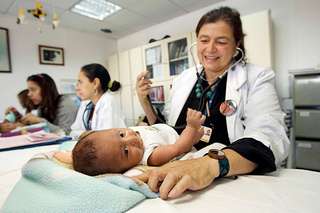Overall, 81 per cent of those born extremely premature were readmitted to hospital, compared to 55 per cent for full-term. Credit: Pan American Health Organization
The chances of a preterm baby needing rehospitalisation decrease sharply five years after birth, and are similar to those born full-term once the individual has reached adolescence, according to recent research.
The findings come from a Telethon Kids Institute retrospective cohort study tracking the hospital admissions of preterm babies for the first 18 years of their lives, drawing on 721,702 individuals born in WA from 1980 to 2010.
The cohort consisted of 1314 extremely preterm, 3629 very preterm, 4866 moderate preterm, 34,841 late preterm and 195,036 early term births.
"The highest rates of rehospitalisation were found for extremely preterm births, but rates were also significantly higher for other gestational age categories examined, including early term births and post-term births,"Professor Helen Leonard says.
"The effect of gestational age on rehospitalisation was highest during the first year after birth discharge, declined thereafter, and had almost disappeared by adolescence."
Individuals born extremely premature average six hospital readmissions by the age of 18 which is more than three times the rate of children born full-term.
Overall, 81 per cent of those born extremely premature were readmitted to hospital, compared to 55 per cent for full-term.
Preterm deliveries on the rise
While overall infant rehospitalisation rates have declined in WA over time, researchers say the findings still raise questions about how we approach childbirth, noting preterm deliveries are on the rise.
"The proportion of babies born early term (37-38 weeks) has increased from 20 per cent in the 1980s to 30 per cent in the 2000s, and findings from our data up to one year of age indicate that they have an excess risk of rehospitalisation compared with term births," Prof Leonard says.
"Regardless of the reason for delivery, a large number of babies are born early term or late preterm for which there may be a substantial burden on health services."
Early deliveries are attributed to an increase in planned births through induction of labour or pre-labour caesareans, half of which are performed on women who have a low-risk of birth complications.
Prof Leonard says the study represents an important contribution because previous investigations into preterm births and rehospitalisation have almost exclusively focussed on the first few years of life.
"The main strength of our study is the availability of 30 years of linked demographic and hospital morbidity data on a large, stable population with low out-of-state migration," she says.
More information: Slimings, C., Einarsdóttir, K., Srinivasjois, R. and Leonard, H. (2014), "Hospital Admissions and Gestational Age at Birth: 18 Years of Follow Up in Western Australia." Paediatric and Perinatal Epidemiology, 28: 536–544. doi: 10.1111/ppe.12155
Journal information: Paediatric and Perinatal Epidemiology , AGE
Provided by Science Network WA



















